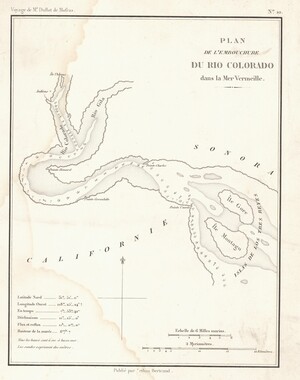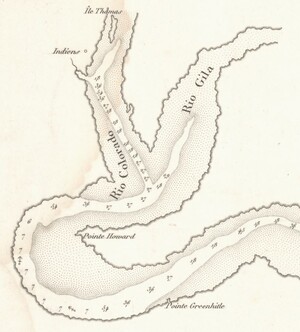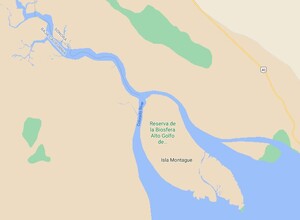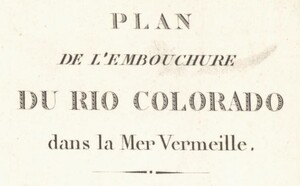Our June Map of the Month is this 1844 Plan de l'embouchure du Rio Colorado dans la Mer Vermeille (English title: Plan from the Mouth of Rio Colorado in the Ruddy Sea). It is a French survey of the mouth of the Colorado River that displays information on the river’s depth, islands, and other navigational details.

Plan de l'embouchure du Rio Colorado is one of several maps produced during Eugène Duflot de Mofras’ voyage to map the mouth of the Colorado River as well as the West Coast of Mexico, Baja California, and the future West Coast of the United States. This map of the Colorado River mouth is the most significant of the series because it is the first known map of the Colorado River as well as the first map that focused entirely on an Arizona area. It marks the beginning of an interest in the Colorado River that would develop throughout the eighteenth and nineteenth centuries, resulting in several more extensive mapping expeditions.

Aside from documenting the path of the Colorado River, this map also highlights several important navigational details. There are frequent notes to show the river’s depth in meters at a given point and several anchorages marked with an anchor symbol, indicating that Duflot de Mofras’ crew was regularly depth sounding and surveying the makeup of the river bed. There is also a point labeled “Indiens” to mark an Indigenous settlement or group living in the area. In addition to these cartographic details, there is a chart with several general navigational details, including latitude and longitude, the time the journey took, and the declination and ebb and flow of the Colorado River.

Several expeditions, such as those of John Wesley Powell and the U.S. Geological Survey, continued the exploration that began with the Duflot de Mofras voyage. The Powell Expedition of 1869 expanded knowledge of the Colorado River by mapping part of the northern half of the river (focusing on the Grand Canyon branch). Then, in the early 1900s, the U.S. Geological Survey went on to produce a groundbreaking survey of the Colorado River throughout all of Arizona and into Colorado in great detail. The contents of this survey and more information about it can be found in our Plans and Profiles of the Colorado River digital collection.

Plan de l'embouchure du Rio Colorado also provides insight into the oldest documented topography of the Colorado River’s mouth. As with any geographic feature, the river’s path and shape have changed over time (as shown above), so this map allows for greater understanding of what the region was like over 150 years ago.

We hope you enjoyed this look at June’s Map of the Month! If you would like to get a high-resolution scan of the map or schedule an appointment to explore the collection in person, please submit a service request to the Map and Geospatial Hub.
-Kelsey Kerley, Map and GIS Assistant